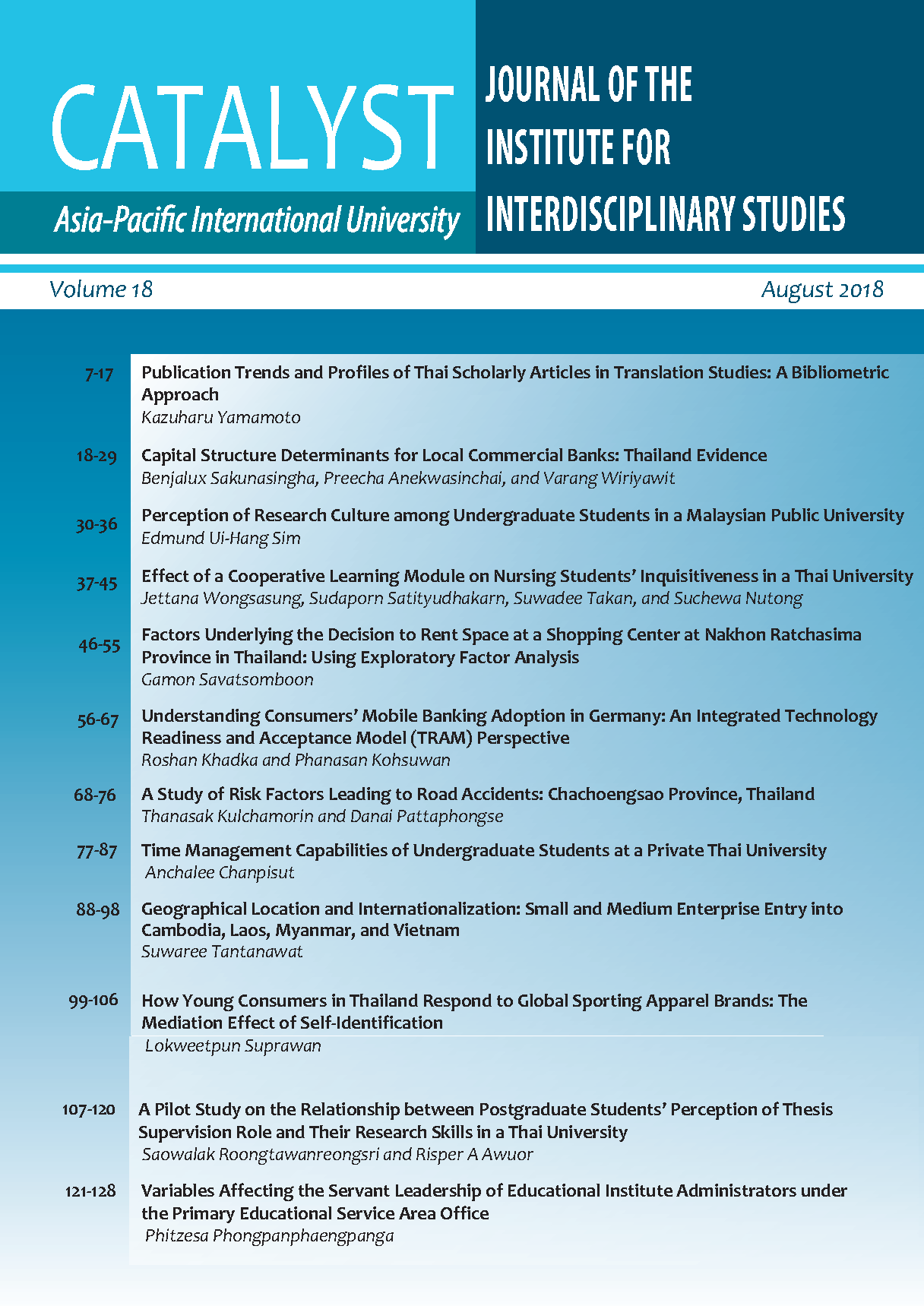A Study of Risk Factors Leading to Road Accidents: Chachoengsao Province, Thailand
Main Article Content
Abstract
The objectives of this research were to study: 1) personal factors of automobile drivers in Chachoengsao Province, Thailand; 2) their driving behavior; 3) risk factors influencing the chance of having an accident; 4) measures used to avoid or reduce the impact of an accident; and 5) their attitudes towards both controllable and uncontrollable driving risks based upon their personal factors. The sample consisted of 400 drivers; statistics used included both descriptive and inferential statistics. The majority of respondents were female, married, 36-40 years of age, bachelor degree graduates, and worked for private enterprises. They had non-permanent driver licenses in their possession for 3-5 years and had 10-20 years driving experience. Their overall attitudes towards controllable risk factors showed high scores on a given rating scale. Among controllable risk factors influencing the chance of having an accident, in descending order of magnitude, were violation of a traffic light, violation of a speed limit, texting while driving, and no signal given to other drivers. Uncontrollable risk factors influencing the chance of having an accident, in descending order of magnitude, were drunk driving, driving on damaged roads, driving when the rate of traffic is high, and driving on narrow roads.
Article Details

This work is licensed under a Creative Commons Attribution-NonCommercial-NoDerivatives 4.0 International License.
Copyright: Asia-Pacific International University reserve exclusive rights to publish, reproduce and distribute the manuscript and all contents therein.
References
Fell, D. (1994). Safety Update: Problem definition and countermeasure summary: fatigue. New South Wales Road Safety Bureau, RUS No. 5.
Heinrich, H.W. (1931). Industrial accident prevention: a scientific approach. New York: McGraw-Hill.
Karnjanaphen, E., Luethep, P., & Thaneerananont, P. (2013). Crash investigation of public vans and buses: A case study of Southern Thailand. Paper presented in 18th National Conference on Civil Engineering (NCCE). The Empress Hotel, Chiang Mai. Retrieved from http://trsl.thairoads.org/FileUpLoad/ 1502/141004001502.pdf
Knipling, R. and Wang, J. (1994). Crashes and fatalities related to driver drowsiness/fatigue. U.S. Department of Transportation. National Highway Traffic Safety Administration. Retrieved from https://trid.trb.org/ view/ 415055.
Kudryavtsev, A. (2012). Road traffic crashes in Arkhangelsk, Russia in 2005-2010. A Dissertation for the Degree of Philosophiae Doctor, University of Tromso, Faculty of Health Sciences, Department of Community Medicine. Retrieved from https://munin.uit.no/bitstream/handle/ 10037/4786/ thesis.pdf? sequence =2.
National Institute of Health (n.d.). What risk factors do all drivers face? Eunice Kennedy Shriver National Institute of Child Health and Human Development. Retrieved from https://www.nichd.nih.gov/health/ topics/ driving/conditioninfo/risk-factors.
Peterson, D. (1978). Techniques of safety management, 2nd Edition, McGraw Hill.
Sivak, M. & Schoettle, B. (2014). Mortality from road crashes in 193 countries: A comparison with other leading causes of death. Transportation Research Institute, University of Michigan, Ann Arbor. Report No. UMTRI-2014-6. Retrieved from http://citeseerx.ist.psu.edu/viewdoc/ download?doi= 10.1.1.650.4951 &rep=rep1& type=pdf.
Stephens, N., & Ohtsuka, K. (2014). Cognitive biases in aggressive drivers: Does illusion of control drive us off the road? Personality and Individual Differences 68, 124-129. Retrieved from http://isiarticles.com /bundles/ Article/pre/pdf/77516.pdf.
Suriyawongpaisal, P. (Ed.) (2015). Key facts on road safety situations in Thailand: 2012-2013. ThaiRoads Foundation & Thailand Accident Research Center, Asian Institute of Technology. Retrieved from http://www.roadsafetythai.org/uploads/ userfiles/file_20151224095849.pdf.
Thanadulburin,T. (2011). Evaluation of awareness in accidents on the part of parents and car drivers. (Master’s Thesis). Chiang Mai University, Faculty of Economics.
Tongtua, K.(2012). The creation of road safety culture on the part of students and people living in the vicinity of Ubolrajthani University. Thai Health Organization. Retrieved from http://roadsafetythai.org/uploads/ userfiles/ACC_54008.pdf.
Wang, P., Rau, P.P. and Salvendy, G. (2011). Chinese drivers’ risky driving and risk taking in other life situations. International Journal of Occupational Safety and Ergonomics (JOSE), Vol. 17 (2), 155–164. Retrieved from https://doi.org/10.1080/10803548.2011.11076886.
World Health Organization (2015). Global status report on road safety 2015. WHO Press. World Health Organization, Geneva, Switzerland. Retrieved from http://www.who.int/violence_ injury_ prevention / road_safety_ status/2015/en/


